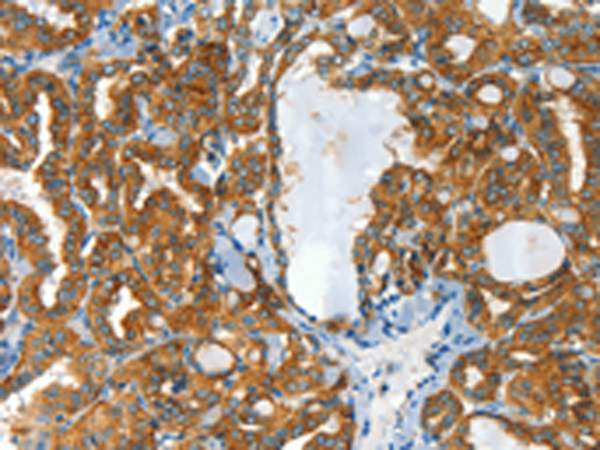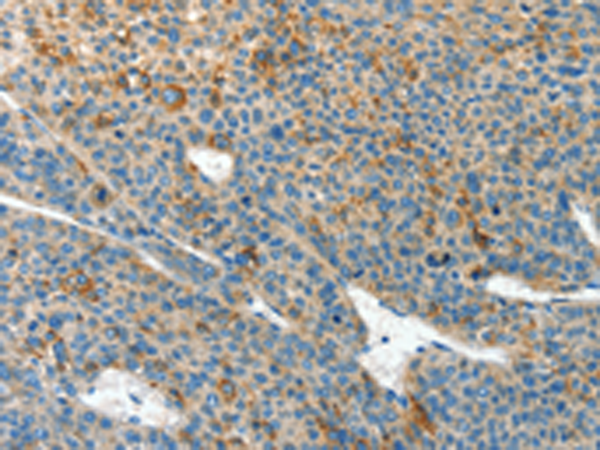


| WB | 咨询技术 | Human,Mouse,Rat |
| IF | 咨询技术 | Human,Mouse,Rat |
| IHC | 1/50-1/200 | Human,Mouse,Rat |
| ICC | 技术咨询 | Human,Mouse,Rat |
| FCM | 咨询技术 | Human,Mouse,Rat |
| Elisa | 1/1000-1/2000 | Human,Mouse,Rat |
| Aliases | CRR9 |
| WB Predicted band size | 62 kDa |
| Host/Isotype | Rabbit IgG |
| Antibody Type | Primary antibody |
| Storage | Store at 4°C short term. Aliquot and store at -20°C long term. Avoid freeze/thaw cycles. |
| Species Reactivity | Human |
| Immunogen | Synthetic peptide of human CLPTM1L |
| Formulation | Purified antibody in PBS with 0.05% sodium azide and 50% glycerol. |
+ +
以下是3-4条关于 **CLPTM1L抗体** 的参考文献及其简要摘要:
---
1. **文献名称**: *CLPTM1L promotes tumor progression through regulating the AKT/mTOR signaling pathway in non-small cell lung cancer*
**作者**: Zhang Y, et al.
**摘要**: 本研究利用CLPTM1L抗体进行免疫组化(IHC)分析,发现CLPTM1L在非小细胞肺癌组织中高表达,并通过激活AKT/mTOR通路促进肿瘤增殖和转移,提示其作为潜在治疗靶点的可能性。
2. **文献名称**: *CRR9/CLPTM1L is required for cisplatin resistance by modulating the mitochondrial apoptotic pathway*
**作者**: Smith JL, et al.
**摘要**: 通过Western blot(WB)和免疫荧光技术结合CLPTM1L抗体,研究发现CLPTM1L通过抑制线粒体凋亡途径增强卵巢癌细胞对顺铂的耐药性,为化疗耐药机制提供了新见解。
3. **文献名称**: *CLPTM1L interacts with telomerase reverse transcriptase and regulates telomere length*
**作者**: Tanaka R, et al.
**摘要**: 使用CLPTM1L抗体进行免疫共沉淀(Co-IP)和共定位实验,证实CLPTM1L与端粒酶(TERT)直接结合,参与端粒长度维持,可能在衰老和癌症发生中起关键作用。
4. **文献名称**: *CLPTM1L as a biomarker for early detection and prognosis in gastric cancer*
**作者**: Wang H, et al.
**摘要**: 通过CLPTM1L抗体的免疫组化检测胃组织样本,发现CLPTM1L在早期胃癌中显著上调,其表达水平与患者生存率负相关,提示其作为诊断和预后标志物的潜力。
---
以上研究均通过CLPTM1L抗体开展蛋白水平分析,涵盖肿瘤发生、耐药机制及分子机制探索。如需具体文献来源,建议在PubMed或Web of Science中检索标题或作者名获取全文。
The CLPTM1L (Cleft Lip and Palate Transmembrane 1-Like) protein, encoded by the *CLPTM1L* gene on chromosome 11q13. is a transmembrane protein implicated in diverse cellular processes, including apoptosis regulation, DNA repair, and chemoresistance. Initially identified for its homology to RAD51. a key DNA repair protein, CLPTM1L gained prominence due to its association with cancer susceptibility. Genome-wide studies linked the 11q13 locus (containing *CLPTM1L* and *FADS1/3*) to increased risk for lung, pancreatic, and other cancers. CLPTM1L is overexpressed in multiple cancers and promotes tumor progression by enhancing cell survival, proliferation, and resistance to chemotherapy.
CLPTM1L antibodies are critical tools for studying its expression, localization, and functional roles. These antibodies enable detection via techniques like Western blotting, immunohistochemistry, and immunofluorescence, aiding in biomarker research and mechanistic studies. CLPTM1L's interaction with proteins like BIRC6 (an apoptosis inhibitor) and its role in modulating Wnt/β-catenin or EGFR pathways highlight its therapeutic relevance. Antibodies targeting specific domains (e.g., extracellular loops or cytoplasmic regions) help dissect its structure-function relationships.
Recent studies also explore CLPTM1L’s potential as a therapeutic target, with antibodies under investigation for diagnostic or blocking applications. However, challenges remain in understanding its precise molecular mechanisms and tissue-specific roles. CLPTM1L antibodies thus serve as essential reagents in both basic research and translational oncology.
(Word count: 247)
×